Methods That Matter:
Six Structures for Best Practice ClassroomsHarvey
Daniels and Marilyn Bizar
York, Maine; Stenhouse Publishers, 1998 |
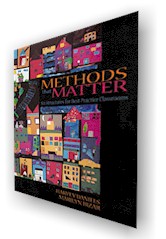 |
Reviewed by Rick Chambers
Harvey Daniels is a passionate advocate for active learning. He
believes in democratic classrooms where children and teachers co-operatively set agendas
and learn together. As he says, "Simply inviting students to express their interests
and curiosities is a big step toward authenticity. When students are given a voice and
some degree of choice, when they are asked to think about how the learning should proceed,
it is more likely that they will be able to see the importance in what they are
doing."
In Methods that Matter: Six Structures for Best Practice Classrooms, Daniels and Bizar
present "six structures or patterns … applicable to all grade levels and subject
areas, from early childhood through college. They are the building blocks of instruction
that allow teachers to organize the ingredients of schooling: students, time, space,
materials, experiences, and assistance."
All six structures – integrative units, small group activities,
representing-to-learn, classroom workshop, authentic experiences, and reflective
assessment – are predicated upon the teacher’s creation of a classroom
environment that emphasizes choice, responsibility, expression and community. "For
human beings to assimilate information they must somehow act on it." The importance
of classroom strategies and management techniques that foster an atmosphere of shared
learning is at the heart of Methods that Matter.
"Students can no longer be viewed as cognitive living rooms into which the
furniture of knowledge is moved and arranged, and teachers cannot invariably act as
subject-matter experts. Sometimes, teachers need to be generalists, becoming learners
alongside their students." This change in emphasis demands a change in approach.
"These structures demand more management from teachers and more discipline among
students than traditional presentational methods."
The risk-taking for teachers in implementing these approaches to student learning
involves forsaking the control of the information. As Dale Halter, one of the teacher
contributors to the book says, "In the workshop approach… the teacher serves not
just as a presenter of mathematics, but as a co-learner, a model, and side-by-side
participant as students work. By joining in investigations alongside our students, we
honor their work; we naturally demonstrate how adult learners tackle mathematical
questions; we gain firsthand understanding of the rewards and difficulties of the
kids’ work; and we receive a wealth of teaching opportunities."
The book presents the theory behind each approach, and then uses teacher experiences to
illustrate the point. And the emphasis is always on activity. "For learners to
internalize ideas, they must act on them. Knowledge cannot remain external, inert,
untouched. Learners must do something with information – connect it, draw it, weigh
it, manipulate it."
The authors point out that the classroom workshop "derives from the insight that
children learn by doing, and that in the past schools have simply failed to provide enough
time for doing math, science, reading, writing, art, music, and history. It recognizes
that kids need less telling and more showing, that they need more time to do learning, and
less time hearing about what particular subjects might be like if they ever engaged in
them."
Daniels and Bizar subtly reinforce for readers the importance of a democratic approach
to classroom management where teachers become coaches, facilitators, leaders, informed
participants, and co-learners. With teachers modeling the learning process with their
students, they are showing the children how to be lifelong learners.
Methods that Matter is a practical, student-centred, reform-oriented guidebook for
teachers who believe that children’s active learning in a collaborative environment
supports the idea that schools can create community and support democracy.
Rick Chambers, who taught English for 27 years, is a program officer in the
College’s Professional Affairs Department.
Pride and
Prejudice:
Working with Lesbian, Gay and Bisexual YouthMargaret
Schneider, Editor
Toronto, Central Toronto Youth Services, 1997 |
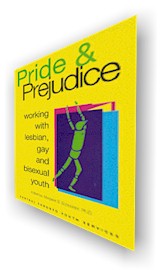 |
Reviewed by Rosemary Evans and Meredith Hill
"Lesbian, gay and bisexual youth
sit in every classroom in every school in our communities. Often invisible, they are
required by law to attend institutions of learning which ignore and stigmatize them."
The authors of Pride and Prejudice are very clear that as
educators we do work with these young people. The degree to which we serve them could be
greatly enhanced by reading this book.
For us, the opportunity to read this new book was timely.
When our school recently held a series of workshops addressing equity issues, three young
people associated with the former Toronto Board’s Human Sexuality Program addressed
Grade 11 and 12 classes in a workshop on "Homophobia in Our Schools."
Rather than actually tackling the issue of homophobia, the
workshop became a forum where our students could ask basic information questions about
homosexuality. It was important learning for them. However, it was also important for the
workshop organizers and the attending teachers to recognize the amount of work to be done
to address the invisibility and stigmatization of gay youth.
The authors of Pride and Prejudice bring to this collection
of articles their years of experience with lesbian, gay and bisexual youth in Toronto and
New York.
PERSONAL ACCOUNTS
Their treatment of the issues facing these young people is
grounded in extensive interviews and case studies, which, by themselves, speak volumes. In
fact, in our reading we both found ourselves jumping ahead to get to the shaded areas of
text in which the youths’ voices told their stories. The power of these personal
accounts is the point of entry into the analyses of the issues.
The analyses themselves are clear, reflective and thoughtful.
Both the experiences of the young people and the strategies of the service providers are
examined through different chapters focusing on homelessness, anti-gay violence, HIV/AIDS,
coming out and child welfare. If only to learn what our students face in dealing with
those issues, the book is invaluable. The book is also an important resource for educating
ourselves about the systems in place – and not in place – to help these
students.
The authors write clearly and helpfully about the double
whammy that these youth face in negotiating the ordinary minefield of adolescence and at
the same time the process of coming out to themselves. The interface between adolescent
psycho-social development and the naming and acceptance of les/bi/gay sexual identity
creates a daunting task.
LONELY JOURNEY
The treatment of these complexities is helped by the
authors’ skill in presenting the significant difference in the ways that gay and
lesbian and bisexual youth navigate them, reflected in poignant personal accounts and
staggering statistics – a suicide rate three times higher than straight teens, a
highly disproportionate presence among street youth, higher rates of substance abuse, and
a greater rate of underachievement, truancy and school dropout. Adolescence is a lonely,
very difficult journey for gay youth in a straight world.
Clearly, the chapter "Making the Grade" which
specifically addresses the situation in the schools is the most immediately relevant for
teachers. Here again, the case studies and interviews about gay youths’ experiences
in schools are painful wake-up calls to teachers and administrators committed to making
the school system a just and safe place of learning for all youth.
This book can open our eyes to the depth of the need for
change and provide support and concrete help for individual teachers’ initiatives.
Rosemary Evans taught history and was a social science
co-ordinator with the Peel board and is now vice-principal of East York Collegiate in
Toronto. Meredith Hill teaches history and ESL at East York Collegiate.
Arresting Violence
A Resource Guide For Schools And Their CommunitiesBy
Peter Ross
Toronto, Elementary Teachers’ Federation of Ontario,
1998 |
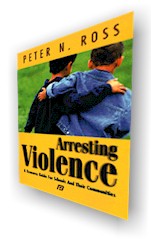 |
Reviewed by Alan Gotlib
The Ontario Public School
Teachers’ Federation commissioned Peter Ross to write this book about bullying and
violence, which will be invaluable, not just to teachers and administrators, but also to
parents. Ross has a special interest in school violence, and with his background as a
teacher, principal and superintendent, he has been able to bring together a wealth of
valuable information.
Ross’s approach to dealing with violence in our schools
is what he terms an ecological one. This takes into account the four worlds in which
children grow up – the family, the school, peer relationships and the community.
Acknowledging these influences on the child makes it clear that parents, along with
teachers and administrators, must play a part in eradicating violence from our schools.
Arresting Violence is a comprehensive resource guide that
comes with a CD-ROM of 165 slides for use at school council meetings and other appropriate
settings. The book offers much-needed insight into understanding both aggressors and
victims. The chapter on bullying is extremely well-detailed with frightening statistics
about the number of incidences of bullying in our schools and a particularly enlightening
section about the "myths that sustain bullying."
It was interesting to discover that beyond the schoolyard,
bullying is more likely to occur in hallways or classrooms than in unsupervised areas like
washrooms or on the way to and from school.
Gangs in schools are also examined, providing insight into
how they form, what kinds of activities they engage in and, most importantly, strategies
to deal with them. These strategies involve teachers, administrators and parents.
The chapter on "Law and Violence" in the School
will interest many teachers and administrators. It’s important that principals and
teachers understand the implications of the law on discipline and on the establishment of
safe schools. There is often a concern among teachers and principals that the courts will
not be supportive if they discipline students.
Ross describes a number of court cases that relate to issues
of school discipline and the outcomes. In some cases, teachers have been supported, while
in others, teachers have been found guilty of assault. Ross concludes, "Teachers,
then, are unlikely to be convicted of assault if they use reasonable force and if their
actions are intended to prevent harm to another student during a fight." Of course,
each case is different, but it is helpful to see how some of these incidents have been
handled.
This book should be in every school. It should also be made
available to parents, enabling the whole community to work at eliminating violence in our
schools. Ross has obviously worked hard to create an invaluable resource guide – one
that is long overdue.
Arresting violence is available for $24.95 direct from ETFO
at 1-888-838-3836.
Alan Gotlib teaches at the Claude Watson School for the
Arts in Toronto. He is the author of ‘B’ is for Bully, a musical play about
bullying and what children can do to stop it.
| Starting Blocks Audrey Gray, Patrick Gray and John Taras
Saskatoon, Paras Publishing, 1997 |
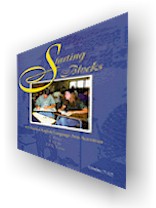 |
Reviewed by Lawrence Marshman
The user-friendly format of this
resource book for intermediate and senior English classes makes it an impressive and
useful tool for the experienced English/Language Arts teacher.
The user has been considered in everything, from the
spiral-ring softcover format to the large type face and the comprehensive table of
contents and index. The table of contents allows the user to access a wide range of
writing activities that easily tie into the themes and issues dealt with in most
English/Language Arts classrooms.
For example, writing activities are divided into units
dealing with themes and issues such as Love, Friendship, the End of Innocence, the Law,
Jobs, Complaints. Nor are the various genres taught in English/Language Arts classes
ignored. A nice balance to the themes represented in Starting Blocks is provided by units
devoted to Interviews/Letters, Dialogue, Response Writing.
The appendix provides an excellent black line master for an
essay planning sheet as well as an explanation and example of its use for an essay on The
Glass Menagerie. These are followed by the final draft of the essay in which the steps
involved in planning the essay have been indicated clearly by shading and margin notes.
Each unit of Starting Blocks provides a wide range of
activities revolving around a major theme or issue and its various aspects. The activities
of each unit are varied enough that they address the needs of learners with the wide range
of abilities one finds in the average English/Language Arts classroom.
For example, in the unit "That’s the Law," the
activities include the construction of a judge’s handbook with notes on the
punishment as well as an explanation of why the punishment is appropriate, the creation of
captions under the portraits of criminals, and the composition of a letter to "the
government informing them of your new name and providing reasons for the change," to
name a few. Consequently, the teacher is able to provide learners with a number of choices
that would appeal to their varying interests as well as their skill levels.
Although Starting Blocks provides an excellent resource for
the English/Language Arts teacher, it is not without its limitations. Despite the number,
diversity and challenge of its 445 activities, it is not for the novice. Too many of the
activities lack precise instructions and none provides the learner with an explanation of
how to execute the activity.
Consequently, the user of Starting Blocks must be an
experienced teacher who can plan, structure and frame these activities so that the learner
experiences success rather than frustration in trying to figure out what the teacher
wants.
The authors tell us that the guide "was originally
designed to be used in a transactional/constructivist … classroom." The user may
want a more detailed explanation of this jargon than that provided by the introduction.
These limitations notwithstanding, Starting Blocks would be a
welcome resource in any English/Language Arts department.
Lawrence Marshman is head of English at Central Etobicoke
High School in Toronto.
| The Canadian Oxford
Dictionary Toronto, Oxford
University Press, 1998 |
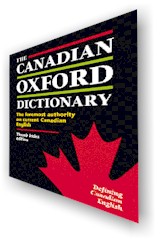 |
Reviewed by Christopher Ball
There’s nothing more central to
what makes us Canadian than our spelling and use of the language, unique turns of phrase
and pronunciations. How many of us have bristled when our spell checker suggested the
American spelling at every opportunity?
There is a lot more to this Canadian edition than one might
expect. Once you get past the "colour" and "schedule" issues, this is
more than a superficial revamping of an American or British edition. Multiple
interpretations of some words take on a different priority in our country. Ask for a
scraper in the southern states and you’ll get a paint scraper. In England, the
scraper is at the back door to clean your boots. What would you expect to see listed first
and foremost for Canadians? Right! A windshield ice scraper.
Some words are so innately Canadian that I would never have
given it a second thought. To "book off" work, take "March break," and
contribute to an "RRSP" for example. Then there is language of the east coast
loggers, west coast fishers, north country trappers and the French settlers. All these are
part of the history of our country and unique to our language. If you’ve listened to
loggers and miners and think little of their language could be printed in a dictionary,
you might be surprised.
Another interesting feature of this dictionary is its
inclusion of brief biographical entries for nearly a thousand noteable Canadians from
Nellie McClung to Elvis Stojko, along with thousands of entries for international figures.
Add to this the names of every town with a population over
5,000, along with the origins of the name, and you begin to see the scope of this
publication. There are even entries for 4,000 historical events, giving this edition an
encyclopedic element.
An admirable, and very Canadian feature, is the inclusion of
words and slang from other nations. This dictionary is not so focused on the Canadian as
to overlook "prat" or "gormless" for instance, and lets us know that
these are British terms. You’ll even find "buddy" and "mac" with
the American, Canadian and British meanings carefully outlined.
For all that it includes, the Canadian Oxford Dictionary is
still a desk-sized volume. It’s affordable at $39.95, compact and ideal for both
personal and school library use. This well-bound, thumb-indexed publication will make a
valuable contribution to anyone’s reference collection and will stand up to hard use
in a resource centre.
Is anything missing from this volume? Well,
"separatist" gets its own heading, while "feminist" is found only
within the explanation of feminism. Is that an oversight, or just part of what makes us
Canadian?
Christopher Ball is the manager of the College’s
library services.